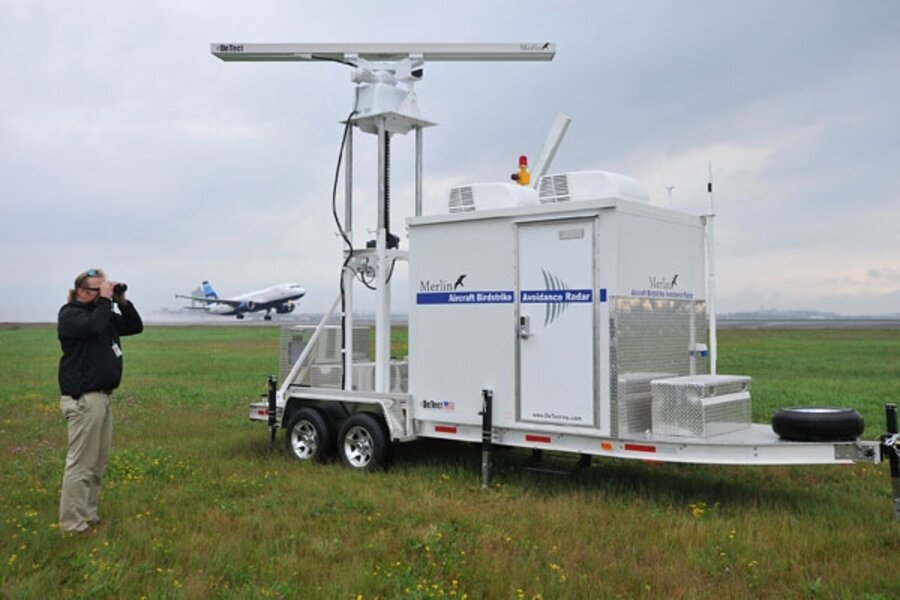Boston airport tests radar to avoid bird strikes
Loading...
| Boston
Logan International Airport is testing a specialized radar system the Air Force uses to protect its fighters and NASA uses to guard its $2 billion shuttles, as it considers stepping up its efforts at preventing collisions between birds and airplanes.With a wildlife mitigation lineup that already includes five full-time employees, Logan has long had an aggressive bird-strike prevention program. It is an attractive landing spot, jutting into Boston Harbor and sitting along coastal migratory routes.
Yet when U.S. Airways Flight 1549 splash-landed in New York's Hudson River after striking a flock of geese, Logan's operators looked to see if there was more they could do.
Now they are evaluating the Merlin Avian Radar System, manufactured by DeTect Inc. of Panama City, Fla.
Merlin allows real-time tracking of birds as small as a starling and as far away as nearly five miles. A spinning blade of a horizontal radar provides an airport overview, while a vertical radar scans a specific runway. Birds appear as red dots, with tails indicating their flight path.
"We're not trying to pinpoint every bird down to a gnat's eyebrow," said Gary Andrews, DeTect's chief executive officer, who demonstrated the radar this week for The Associated Press. "We're trying to document bird patterns for a successful response."
A Merlin system is already being used at Durban International Airport in South Africa, the first commercial airport to install avian radar technology. But cost and technical concerns have limited the spread of it and competing technology.
A second Merlin system sits atop a bird-attracting landfill near a runway at the Louisville, Ky., airport, while a system made by a Canadian competitor, Accipiter Radar Technologies Inc., has been installed at Sea-Tac Airport outside Seattle.
Such systems can be automated to alert air traffic controllers of birds entering landing and takeoff corridors, so specific altitudes and travel directions can be relayed to pilots.
They also can archive bird activity, so biologists can analyze it and better predict when to use their low-tech countermeasures such as dogs, sirens or air cannons.
"Wouldn't it be great if we had some technology to tell us what's over the horizon?" said David Ishihara, director of aviation operations for the Massachusetts Port Authority, which runs Logan.
Experts said the challenge is adapting technology designed to track bigger, slower-moving targets such as ships so it can detect faster, biological targets like birds.
"To really further the science, we need a better antenna," said Matthew Klope, a wildlife biologist who works on bird-strike issues for the Navy at its Whidbey Island Air Station in Washington state.
Bird strikes occur every day at airports worldwide. Most never make the news, because aircraft are designed to withstand them.
That was the case Tuesday, when a Southwest Airlines Boeing 737 struck a flock of birds while taking off from Baltimore-Washington International Airport en route to Providence, R.I. One engine lost power, but the plane safely turned around and landed.
Yet the U.S. Airways incident in January highlighted the danger of a bird strike, even though it occurred at such a distance and altitude from LaGuardia Airport — where the flight originated — that neither bird radar nor scare tactics would have prevented it.
The Airbus A320 struck a flock of Canada geese, which can weigh as much as 12 pounds each. The multiple and sizable hits ended up wrecking both engines, turning the plane into a glider.
Capt. Chesley Sullenberger successfully steered it to a water landing, saving all 155 aboard, but he later acknowledged things could have been worse had he been forced to return to land.
Federal officials recently asked about installing bird radar systems at U.S. airports, though experts say there can be problems with screen clutter. The day the AP viewed the DeTect system, cells of rain co-mingled with radar returns from birds. Andrews said the system still was being calibrated for its new location and could be filtered to limit false alarms.
There is also concern about overwhelming both pilots and air traffic controllers with too much information during takeoff and landing, critical phases of flight.
In addition, there is cost. Trailers like the one at Logan can cost about $400,000 each, and buying enough equipment to cover an entire airport can reach $2 million.
The Air Force believes its worth the price to protect its pilots and avoid costs to repair its airplanes. It's installed six Merlin systems in the United States since 2003 and is planning another overseas. The first was installed in North Carolina at the Dare County bombing range it shares with the Navy.
And NASA has avoided a repeat of a 2005 incident when an 8-pound turkey vulture struck the external fuel tank on space shuttle Discovery. Two DeTect company technicians are on standby for Saturday's planned launch of Endeavour.
Logan is testing a Merlin system for three weeks. The trial has been free, except for fuel Massport has provided to run the trailer's generators. It will test the Accipiter system in the coming months.
Ishihara, the Massport aviation chief, said he hopes the technology proves worthy of the expense.
"It's another tool," he said. "It gives us eyes we may not have today."





